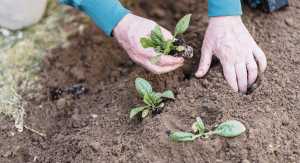Do you find yourself wondering what you should or shouldn’t be planting during the Miami “seasons”? This South Florida edible gardening calendar could come in handy! It’s not the same thing to use planting guides meant for the northern states down here. As you know, we here in South Florida do not have very distinct seasons. Our summers last most of the year, and you do have to make sure that you beat that summer heat when thinking of harvesting time. But there’s a benefit to South Florida gardening. You can begin to plant “spring” vegetables in the fall and winter months, even up to February or March, when those northern states are dealing with freezing temperatures! For that reason, I hope I can be of service to you with this comprehensive guide for what to plant in your edible garden throughout the year.

January
Certain herbs thrive during the somewhat cooler temperatures of the first few months of the year. Plant herbs like tarragon, dill, mint (all kinds), fennel, and thyme. January is a great thyme to plant them! Couldn’t help myself. When it comes to vegetables, you have plenty of options. January is usually the last time to plant kale, brussels sprouts, broccoli, cauliflower, mustard greens, and beets. You can also start with your salad growing, get ready to grow some tomatoes, arugula, salad, and peppers.
February
In February, you’ve got “winter” at its finest down here. Cucumber, lettuce, the ever-popular tomatoes, spinach, peppers, and eggplants, it’s time to plant these! You can continue to grow the same herbs as January, along with oregano, chives, lemon balm, or basil too. As for fruit, get your cantaloupe, papaya, pineapples, passionfruit, and watermelon ready for planting. This is a good time to look out for cold fronts, watering your garden deeply 12-24 hours prior to a projected drop in temperature. We don’t usually get “freezes” but when the temperatures drop low enough, it’s better to be safe than sorry.
March
March tends to be the last month you want to plant certain beans, that cantaloupe you may not have gotten to planting February. Along with finishing planting your arugula, carrots, celery, sweet corn, squashes, radishes, and watermelon. Continue with some of those same fruits as February, and start planting sweet potatoes and yucca. Parsley and tarragon can also be grown in March.
April
In April, you can start planting that delicious basil for some homemade pesto or your Caprese salad. Also, throw in some coriander and cumin into your herb garden and keep up with that yummy mint. Be aware if it’s getting a little dry and make sure to water your garden consistently. Now you can continue planting certain beans like bush beans, lima beans, or pole beans; along with ginger, cabbage, peas, and sweet potatoes. Also try out some tropical spinaches that can keep up with our warmer temperatures.
May
As we get into the summer months, our list does get smaller. You can plant pigeon peas carefully, and keep up with ginger, tropical spinach, and hot peppers. Now is the time to start planting those heat-loving herbs like tarragon, cumin, rosemary, and more basil!
Don’t forget that even though this is an edible gardening calendar, it’s always a great idea to plant flowers in a vegetable garden. Flowers attract beneficial insects by providing nectar and pollen allowing for more pollination. Some flowers are edible too!

June
We enter the hot and rainy month and our list dwindles! You can plant everglades cherry tomatoes still but carefully. Keep growing those heat-loving herbs you started in May. If you’re buying seedlings, you can carefully transplant passionfruit, papaya, and sweet potatoes still.
July
This South Florida edible gardening calendar isn’t the easiest during the summer months but don’t fret, you can still grow some fun things! Some peppers will still do well during this heat of July like cherry tomatoes, sweet potatoes, southern peas, and delicious okra. You can also continue your tropical spinach. Remember if you have plants that are still bearing fruit, leave them alone! Just make sure to check them often for pests, especially when it gets rainy.
August
August brings some new life as you start some seed planting of eggplant, pumpkins, and squashes for your fall garden. Those cherry tomatoes are still great to plant. From seedlings, you can plant ginger, bay laurel, tarragon, and more rosemary but don’t start these from seeds!
September
Edible gardening in September starts to give us more opportunities. Continue with your seeds for beans and squashes, and add in some carrots, onions, and turnips! Everything from June and July can still be grown during September too. Your mint, Mexican tarragon, and rosemary will also continue to tolerate these temperatures right before fall kicks in.
October
Oddly enough, October is a good time to plant spring vegetables too! Thank you, South Florida. Now you can begin again with your arugula, cucumber, tomatoes, corn, more beans, broccoli, collard greens, green onions, various types of spinaches, and peppers. You can now start planting dill, fennel, cilantro, and parsley that have a harder time in summer months. Your pumpkins that you planted in August will be getting big at this point too! One of the greatest things about South Florida edible gardens? Strawberries! This is the best time to plant strawberries as the strawberry season is from October to March, approximately.
November
When you transition from summer to fall gardening, make sure you clear all the dead, diseased, or rotting plants out and supplement your soil before your Fall gardening begins. You can add some compost for a quick nutrient boost. If you didn’t get to strawberry planting in October, now is a great time. Keep up your beans, broccoli, snow peas, and kale too. Along with the same herbs you started in October. Try some celery, radishes, and potatoes during these fall months, as well.
December
While the rest of the country is getting snow and frosts, your South Florida edible garden is thriving and ready for more! Herbs like thyme, dill, sage, parsley, dill, fennel, and cilantro do great in December. There are also trusty cool-season vegetables like tomatillo, broccoli, kale, green onions, carrots, endives, and beets that do excellent in December.

Happy Planting!
I truly hope this South Florida edible gardening calendar gives you a little guidance as to what you can plant throughout the year as you schedule your seed starting or purchasing seedlings for transplant. Remember to include your kids for a great learning opportunity too. Sharing this skill with them teaches them ways to be self-sufficient for the future.
Drop a comment below and let me know what month of planting sounds the most exciting to you (or what you want to eat the most)! Remember, if you have any questions, I am always available to help as much as I possibly can.














This is great, Ana-Sofia! Love it. Definitely going to share with my husband (he’s the one who does our gardening ha!).
Wonderful and very helpful article, especially for some of us that need to be reminded of what to plant each month 😬
Thank you Ana-Sofia!
This is really helpful, thank you! Can any of the summer tropical veggies be planted directly into the sandy soil, or should they all be in raised beds or containers?
Hi Beth! Thanks for your comment! Really you should supplement the soil with gardening soil that contains nutrients and is more hospitable for your veggies. Sure some may survive but you give them a better chance if you give them a good place to grow! You can mix it in with the Sandy soil if you don’t want to use a container or raised bed. Make sure it’s gardening soil and not top soil. Hope this helps!
Comments are closed.